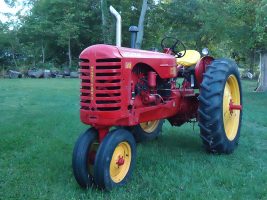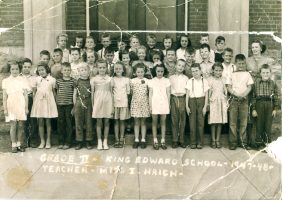By Gerald Richards – Brandon, Man.
When I started school at Halbrite in August, 1949, my teacher was Mrs. Rubin. She taught Grades 1 to 3. In her classroom, there was order and regularity.
We’d have ‘opening exercises’ every morning. We stood by our desks and proudly sang O’ Canada, while Mrs. Rubin led with her voice or a one-finger melody on the piano. We then shared whatever news items we’d heard, either on the radio or overheard our parents discussing. There were days when we were scolded for not paying attention to current events.
After the news came the weather report. Each day we filled in our monthly calendar with the temperature and wind directions. Some days, Mrs. Rubin went into the hall and looked out the window to check the way the wind was blowing the Union Jack.
Then there was the daily health inspection. Mrs. Rubin, or one of her appointed monitors, went up and down the rows checking to see if we had clean hands and fingernails, neatly combed hair, and a fresh hanky.
She also asked if we had slept 10 hours that night. If everyone in the row checked out, she gave us a point.
Singing before learning
Before getting down to our lessons, we sang. In the fall, there was See the Merry Farmer Boy, in which the girls sang a “tra-la-la-la” chorus and the boys whistled – another skill I never quite got the hang of.
During Ham and Eggs, we bobbed up and down as we “flipped and flopped” them. Occasionally, we sang Thumbkin, a song about each of the fingers, which could not dance alone so “Dance my merry men, everyone, and dance Thumbkin (or some other finger’s name), dance.”
Everyday, there was a writing lesson. We practiced our circles and sticks and other exercises from the Bailey Writing Book. We tried to copy the rows of slanted strokes and the overlapping circles as accurately as possible.
When it came time for reading, we had both silent and oral sessions. We lined up at the front of the room and read passages when she called our names. For some, this was a trying moment, and heads bobbed in time to the blurted words.
She helped those who faltered; “Sound it out,” she would say. Later, we sat quietly at our desks working in our Think and Do books. Mrs. Rubin expected us to work quietly while she helped the other grades.
Tom, Huck, and Heidi
Just after lunch, we had roll call. We responded with a clear “present” and waited in anticipation. She entered a stroke beside our name in the class register, blotted the ink, closed and put the register into her top drawer. Then, she reached for a book at the front of her desk.
We were anxious because Mrs. Rubin always read to us for 15 to 20 minutes. We looked forward to hearing what Tom Sawyer, Huckleberry Finn, or Heidi was doing.
Sometimes, the girls made Kleenex flowers or other handicrafts while she read, but most of us were in another world.
In the afternoon, Mrs. Rubin opened our minds to worlds beyond our little prairie village. In science class, she taught us about the law of magnets and the parts of a flower.
We made collections of different kinds of seeds, noting how they were naturally designed for transportation to new sites. We wrote and illustrated booklets called “The Story of a Loaf of Bread.”
In social studies, Mrs. Rubin took us on imaginary trips to the Netherlands, Arabia, and the far North, learning about the way people lived in those, and other, lands found in our little red textbook, Far Away Places.
In health class, she taught us about the ear, and we practiced drawing it. Day by day, we acquired new knowledge in an orderly fashion, all thanks to Mrs. Rubin.



